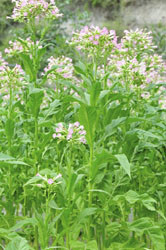Plant messaging system revealed
Plant hormone signalling plays a major role in how leaves protect themselves against attack by herbivorous insects. Scientists also know that roots are crucial to the process, but few herbivore induced leaf-to-root signal have been unambiguously identified. In the EU-funded SHOOT-ROOT-SIGNALING(opens in new window) project, biologists searched for such messengers in wild tobacco (Nicotiana attenuata). They successfully identified several chemical markers that indicated changes in the roots of plants that had been attacked on their leaves. In fact, they determined that sugars, starch and nicotine could serve as robust, reproducible and ecologically relevant markers for assessing shoot-to-root signalling. Although they couldn't identify common messenger molecules between roots and leaves, they did observe a strong, rapid increase in jasmonates and auxin (two phytohormones) in the leaves. Further experiments showed that jasmonates are involved in depleting carbohydrate pools in roots, while auxin is likely to modulate this response. These and other insights gained during the project confirm the involvement of roots in plant responses to herbivory. This work will inform future efforts to understand plant-herbivore interactions and may help to develop herbivore-resistant plant varieties.







